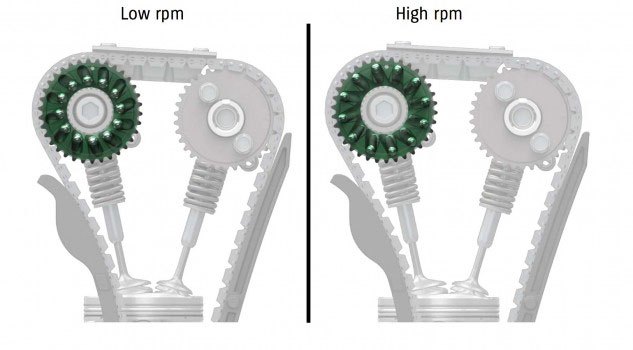TFT (Thin-Film Transistor) Displays
TFT displays are a type of LCD flat-panel display screen in which each pixel is controlled by one to four transistors, which can combine to yield full-color readouts. Not only does this type of display offer great resolution, it allows manufacturers full customization of how the user interface interacts with the rider. In more performance-oriented bikes, we see normal street-riding displays, while more track-focused screens can be made available at the push of a button. Track-specific screens generally focus on tachometer, lap timers, and gear indicators to give trackday enthusiasts an easier intake of information that is important while spinning laps.
As with most technology, now that TFT has been around for most top of the line sport and touring motorcycles, we are seeing the tech trickle down to bikes such as KTM’s 390 Duke which is a great city or beginner bike and now, with high-end accoutrements.
“Some old-school riders may deride the abandonment of analog gauges, as I once did, but TFT instruments are a step forward in delivering all the info a rider needs,” says MO’s Editor-in-Chief, Kevin Duke. You only need to look at modern aircraft and Formula 1 cars to know which way the wind’s blowing. The highly legible and configurable contemporary displays are excellent and significantly add to a gauge panel’s visual appeal.”
TFT Displays earn our Motorcycle.com Best of Technology award for a few reasons; they allow manufacturers to easily update user interfaces and allow end users customization as well depending on their riding disciplines. The potential for future applications of TFT display also include touch capabilities – like on the new Yamaha Star Venture, which works great even with gloved fingers. If you have been around through the early days of phones with touch screens, you have likely used a TFT touch screen on a previous mobile device. As the list of electronics grow on new motorcycles, so too have the control modules on each side of the handlebar. TFT touch displays could be a solution to slimming those plastic bits down to their more svelte days.
Honorable Mention: Suzuki GSX-R1000 Variable Valve Timing
Cars, where an extra pound or 10 is no big deal and there’s plenty of room under the hood, have been varying their valve timing for decades as a means to broaden their powerbands. Motorcycles not so much. After the withering attack upon Honda’s VTEC system in its 2002 VFR800, which the critics panned as too heavy, too complex and too ineffective, it seems like the other manufacturers got the message: KISS.
Ducati went against one of its own design principles when it added Desmodromic Variable Timing to the 2015 Multistrada 1200, since the system also added 11 pounds. Gasp! It was worth it on the Multi, but the added weight is why you don’t see DVT on a Panigale, said Ducati.
Which is all the more reason to be impressed with Suzuki’s adding VVT to its all-new 2018 GSX-R1000. Suzuki Racing VVT (Variable Valve Timing) is way simpler than most systems, and therein lies its genius. What happens is that 12 steel balls running in slanted grooves are spun outward by centrifugal force at high rpm. Their carrier mechanism attaches to the intake cam sprocket, and retards intake cam timing at a pre-set rpm, “adding significantly to high-rpm power” while adding very little weight to the engine’s spinning mass.
Here’s a video to show VVT in action.
The new GSX-R did not win our recent big Superbike Shootout, but a quick look at the dyno chart shows VVT had it running with or ahead of the best of the 1000cc four-cylinders from around 4000 rpm, right up until its noise-quelling software shuts the party down at 11,000 rpm. What might’ve been…
Suzuki says it developed its VVT system in MotoGP racing, where it’s served reliably for quite a few years. Some say we’re too easily impressed by bright, shiny objects, but Suzuki’s 12 steel balls make VVT our Top Tech of 2017.
Motorcycle.com Best of 2017 Categories
Best Technology of 2017 appeared first on Motorcycle.com.
【Top 10 Malaysia & Singapore Most Beautiful Girls】Have you follow?




